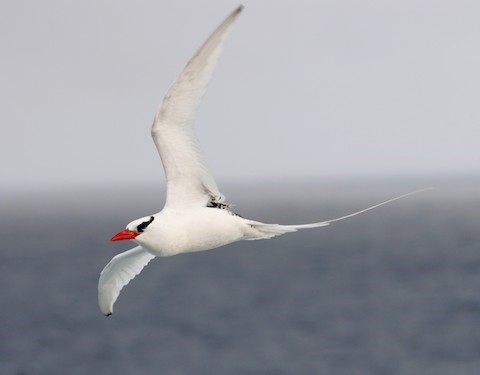Birdfinding.info ⇒ Locally common in several parts of its range, especially in the Gulf of California, the Galápagos, the Leeward Islands, and Cape Verde. Accessible sites where it can be seen reliably from December to June are the large colonies on Saba, St. Eustatius, and Little Tobago Island, and smaller colonies at Windward Point (Anguilla), Guana Bay (St. Martin), St. Barthélemy, Silver Hill (Montserrat), Pointe de la Grande Vigie (Guadeloupe), Pointe des Châteaux (Guadeloupe), Savane des Pétrifications (Martinique), Vieux Fort (St. Lucia), and Green Point (Barbados). In western Mexico, it can be seen on offshore trips from any Pacific port, and from shore at Punta Arena (Baja California), Mazatlán, Zihuatanejo, and Puerto Angel (Oaxaca). In the U.S., it is most often observed in Gulf Stream waters from May to September, especially off of Cape Hatteras, North Carolina, where it occurs alongside Catesby’s Tropicbird. A few are seen annually in the waters of southern California from August to October.
Red-billed Tropicbird
Phaethon aethereus
Tropical Atlantic and eastern Pacific Oceans.

Approximate range of the Red-billed Tropicbird. © BirdLife International 2019
Breeding. Nests mainly on rocky islets and cliffs. Breeding areas are clustered in five regions: (1) western Mexico, on islets from the northern Gulf of California south to Guerrero; (2) the Galápagos and nearshore islands from at least Malpelo (Colombia) to Isla Chañaral (Chile); (3) the eastern and southern Caribbean rim from Puerto Rico through the Virgin Islands and Lesser Antilles to Tobago, and sparingly west to Panama; (4) Cape Verde (Santiago, Brava, Ilhéus do Rombo, and Raso), Senegal’s Îles des Madeleines, and at least occasionally the Canaries (Hierro, Fuerteventura, and Lanzarote); and (5) the South Atlantic islands of Fernando de Noronha, the Abrolhos, Ascension, and St. Helena.
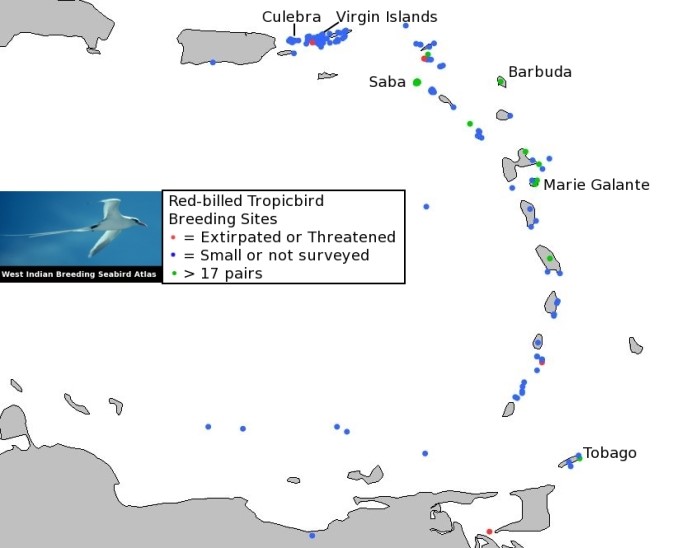
West Indian Breeding Seabird Atlas, 2008. © Will Mackin and David Lee
The Caribbean population breeds from December to June, most (80%) on small islands from the Virgin Islands to Guadeloupe, with the largest colony on Saba (approximately 1,000 pairs). Smaller numbers nest at scattered sites south to Little Tobago (at the eastern end of Tobago). Additional Caribbean breeding sites are in Bocas del Toro, Panama (on Isla Pájaros, a.k.a. Swan Cay) and two groups of Venezuelan islands (offshore on Los Roques and near the coast in Mochima National Park).
Nonbreeding. Nonbreeding birds disperse to the waters around their breeding areas, mainly offshore, but found on and near coasts much more often than other tropicbirds. Regular in summer and fall north to southern California (Point Conception), North Carolina (and probably to Massachusetts), and the Canary Islands.
Often wanders far beyond its normal range: e.g., to Hawaii, Oregon, Nova Scotia, Azores, Portugal, South Africa, and Lord Howe Island, Australia.
There is a notable pattern of vagrants with high site-fidelity, returning to the same area annually for many years. Prominent examples include individuals that spent multiple seasons at Koko Head Regional Park, Oahu, Nantucket, Massachusetts, and Seal Island, Maine.
Identification
Adult is white overall with finely barred upperparts, black bars on the outer primaries, a coral-red bill, a bold black eyestripe, and a long white tail.
In all plumages, Red-billed has extensive fine black barring on the rump, back, and adjacent wing coverts. The barred area can appear grayish at a distance or white in strong light, and sometimes shows an indistinct diagonal carpal bar across the secondary coverts.

Red-billed Tropicbird. (Little Tobago Island, Trinidad & Tobago; March 3, 2008.) © Joel Trick
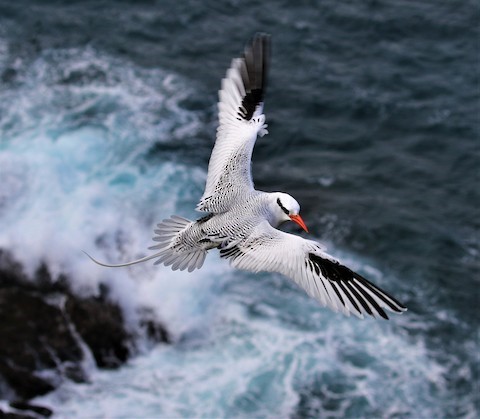
Red-billed Tropicbird. (Little Tobago Island, Trinidad & Tobago; February 17, 2020.) © Larry Schmahl

Red-billed Tropicbird. (Little Tobago Island, Trinidad & Tobago; January 5, 2019.) © Paul Arneson

Red-billed Tropicbird, showing indistinct carpal bars on secondary coverts. (Shoreline Park, Gulf Breeze, Florida; June 3, 2017.) © Brad Bergstrom
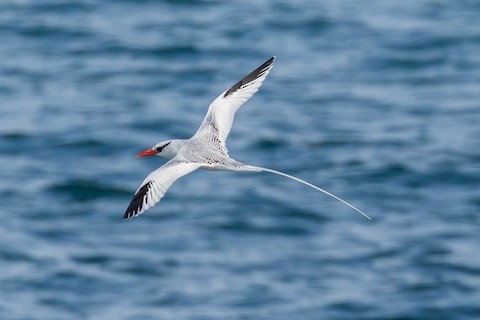
Red-billed Tropicbird. (Isla Santa Cruz, Galápagos, Ecuador; March 19, 2018.) © John Reynolds

Red-billed Tropicbird. (Little Tobago Island, Trinidad & Tobago; February 9, 2018.) © Joshua D. Vandermeulen
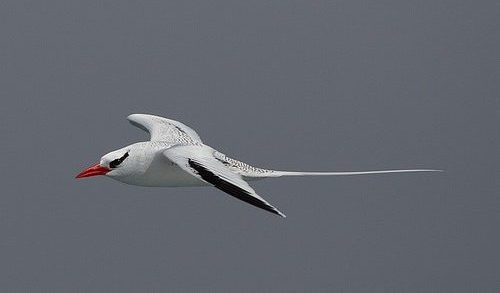
Red-billed Tropicbird. (Isla Genovesa, Galápagos, Ecuador; August 9, 2010.) © John Crosby
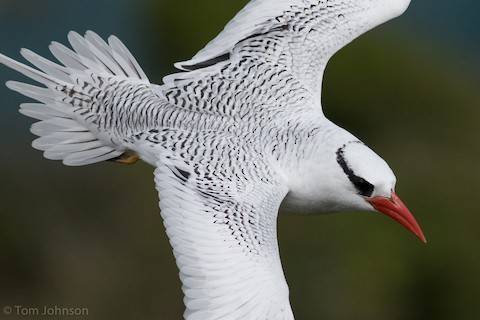
Red-billed Tropicbird, close view of finely barred upperparts. (Little Tobago Island, Trinidad & Tobago; February 15, 2020.) © Tom Johnson
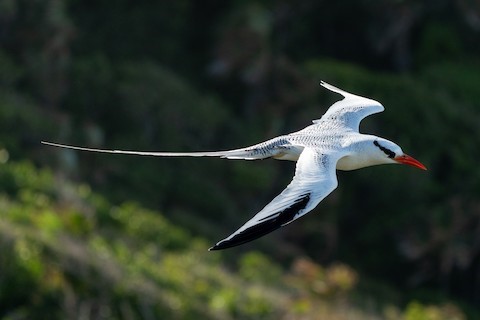
Red-billed Tropicbird. (Little Tobago Island, Trinidad & Tobago; January 13, 2020.) © Steven Hunter
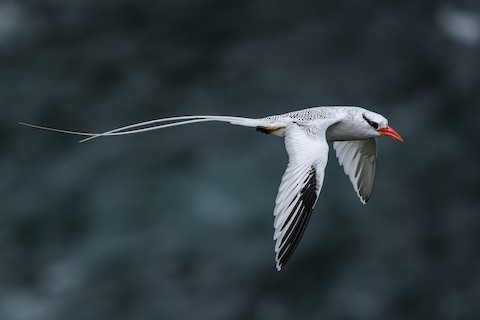
Red-billed Tropicbird. (Little Tobago Island, Trinidad & Tobago; November 20, 2019.) © Steve Rappaport
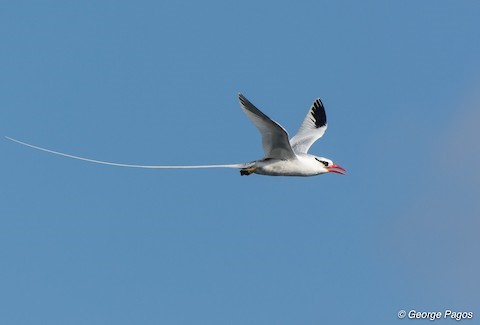
Red-billed Tropicbird with an exceptionally long tail. (Daphne Major, Galápagos, Ecuador; July 14, 2015.) © George Pagos
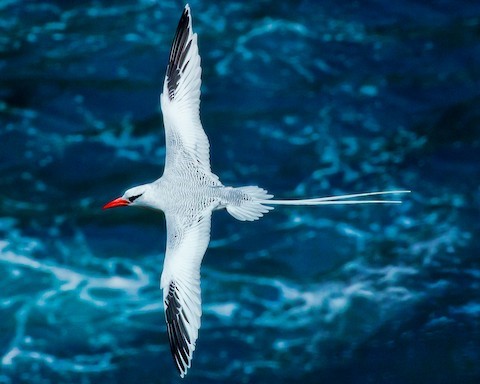
Red-billed Tropicbird. (Little Tobago Island, Trinidad & Tobago; February 13, 2014.) © graichen & recer
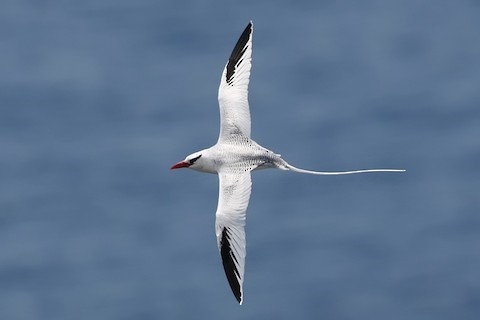
Red-billed Tropicbird, showing nearly all-white upperparts. (Lord Howe Island, Australia; November 19, 2010.) © Tony Palliser
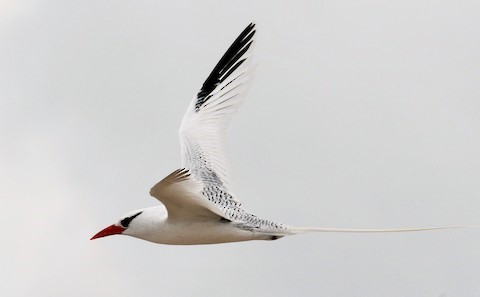
Red-billed Tropicbird. (Gardner Bay, Española, Galápagos, Ecuador; November 4, 2016.) © Neil Wingert
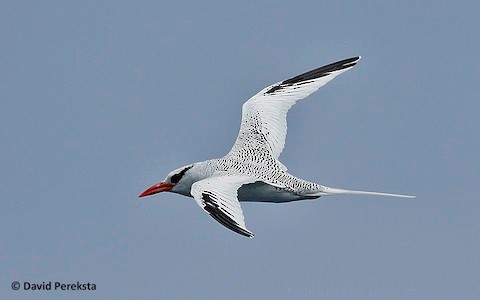
Red-billed Tropicbird, adult with short streamers. (Offshore from San Clemente Island, California; September 8, 2019.) © David Perekstra

Red-billed Tropicbird. (Seal Island National Wildlife Refuge, Maine; July 19, 2014.) © Jay McGowan
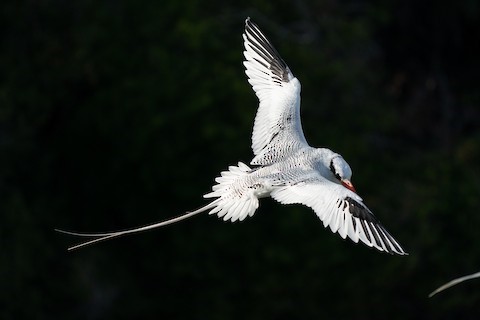
Red-billed Tropicbird. (Little Tobago Island, Trinidad & Tobago; January 13, 2020.) © Steven Hunter
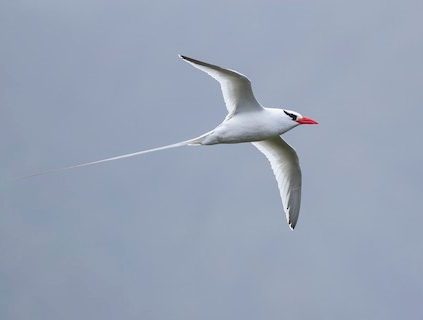
Red-billed Tropicbird. (Little Tobago Island, Trinidad & Tobago; February 24, 2011.) © Peter Hawrylyshyn

Red-billed Tropicbird with an atypically yellow bill. (Praia Cliffs, Ilhas de Sotavento, Cape Verde; March 24, 2018.) © Volker Hesse

Red-billed Tropicbird with a pale, pinkish bill. (Isles des Madeleine National Park, Senegal; January 26, 2018.) © Marie O’Neill
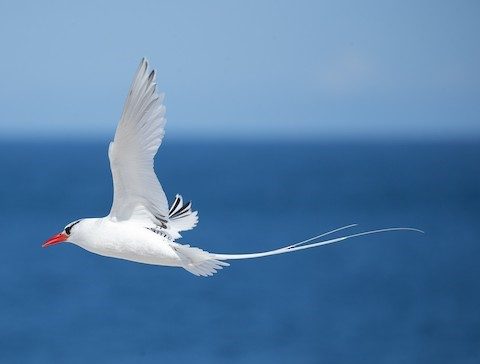
Red-billed Tropicbird. (Punta Suarez, Española, Galápagos, Ecuador; July 24, 2015.) © Meg Barron
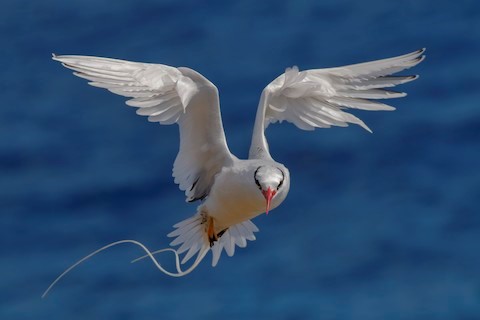
Red-billed Tropicbird. (Lana’i Lookout, Koko Head Regional Park, Oahu, Hawaii; January 20, 2019.) © Sharif Uddin
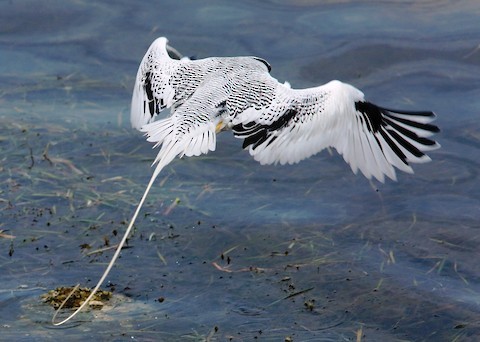
Red-billed Tropicbird. (Shoreline Park, Gulf Breeze, Florida; June 3, 2017.) © Brad Bergstrom
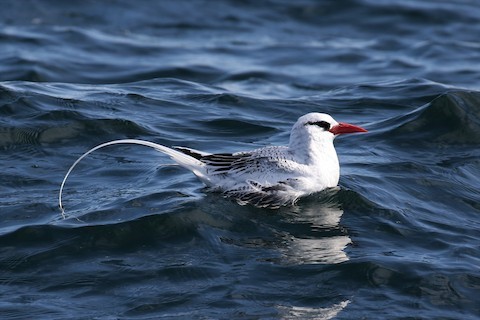
Red-billed Tropicbird. (Vinalhaven, Maine; August 6, 2017.) © David Alpeter

Red-billed Tropicbird. (Lana’i Lookout, Koko Head Regional Park, Oahu, Hawaii; March 3, 2006.) © Michael Walther
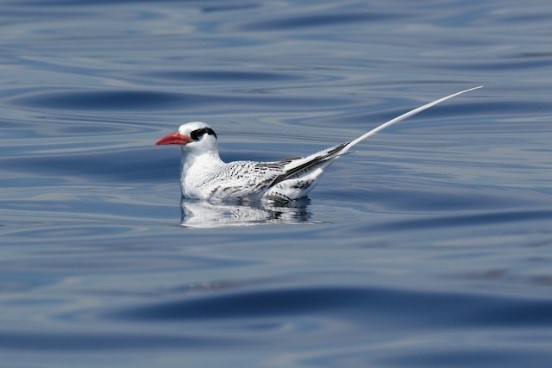
Red-billed Tropicbird. (Offshore from Puerto Angel, Oaxaca, Mexico; March 8, 2007.) © Chris Wood
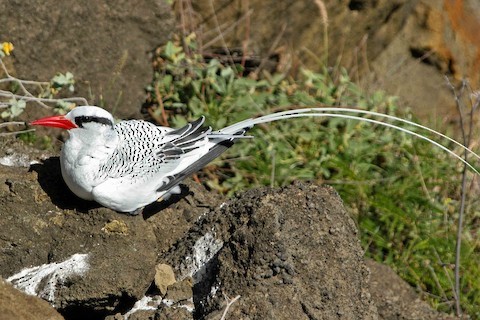
Red-billed Tropicbird. (Lana’i Lookout, Koko Head Regional Park, Oahu, Hawaii; April 2, 2007.) © Eric VanderWerf

Red-billed Tropicbird. (Shoreline Park, Gulf Breeze, Florida; June 3, 2017.) © Brad Bergstrom
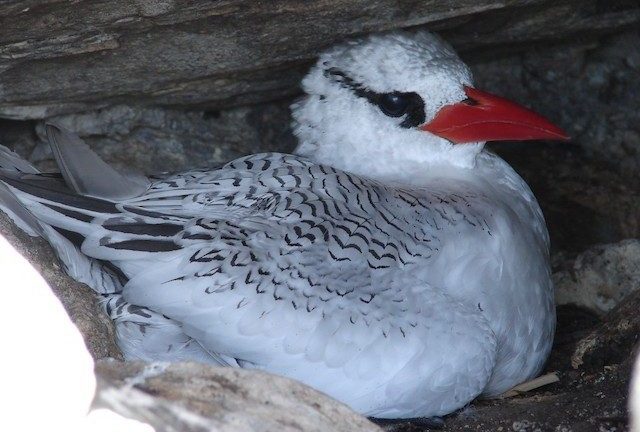
Red-billed Tropicbird, at nest. (Abrolhos, Bahia, Brazil; October 21, 2012.) © Ana Paula Alminhana Maciel
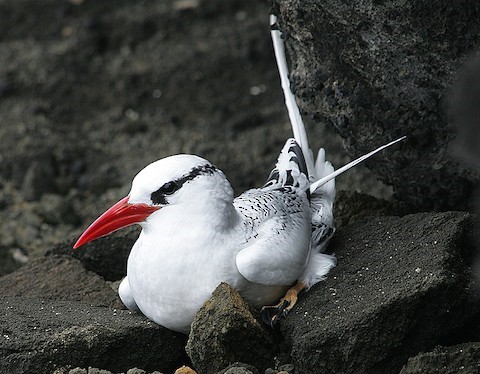
Red-billed Tropicbird. (Lana’i Lookout, Koko Head Regional Park, Oahu, Hawaii; March 3, 2006.) © Michael Walther

Red-billed Tropicbird. (Lana’i Lookout, Koko Head Regional Park, Oahu, Hawaii; February 18, 2020.) © Eric VanderWerf
Immature Plumages. Immatures of all tropicbird species are barred with black across the back, rump, and wing coverts. In Red-billed (as in Arabian), immatures and adults have essentially the same pattern, including the bold black bar on the outer primaries and primary coverts.
Immature Red-billed differs from other immature tropicbirds (except Arabian) in having a pronounced eyestripe that extends back from the eye to the hindcrown and wraps around the nape to form a partial collar.
The juvenile’s bill is pale-yellow and often has blackish contours and edges. The bill progressively becomes yellower, then yellowish-orange, on its way to the coral-red adult color.

Red-billed Tropicbird, subadult. (Offshore from Hatteras, North Carolina; June 1, 2017.) © Skip Russell
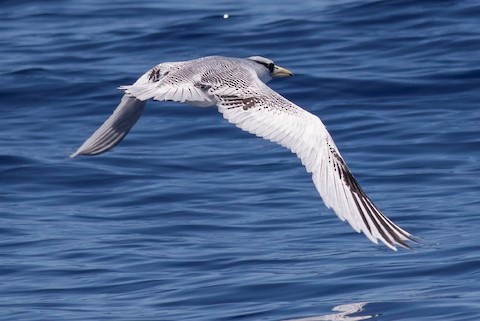
Red-billed Tropicbird, immature. (Offshore from Hatteras, North Carolina; June 1, 2015.) © Michael Todd
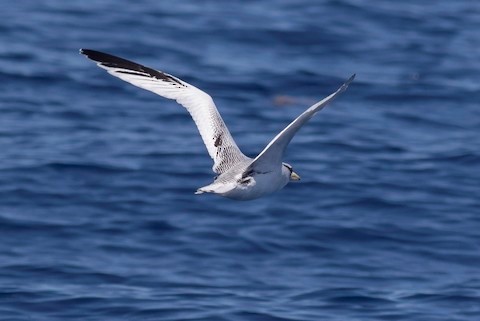
Red-billed Tropicbird, immature. (Offshore from Hatteras, North Carolina; June 1, 2015.) © Michael Todd

Red-billed Tropicbird, subadult. (Thetis Bank, Baja California Sur, Mexico; August 7, 2019.) © Robert McNab

Red-billed Tropicbird, immature. (Nantucket, Massachusetts; August 24, 2014.) © Ian Davies
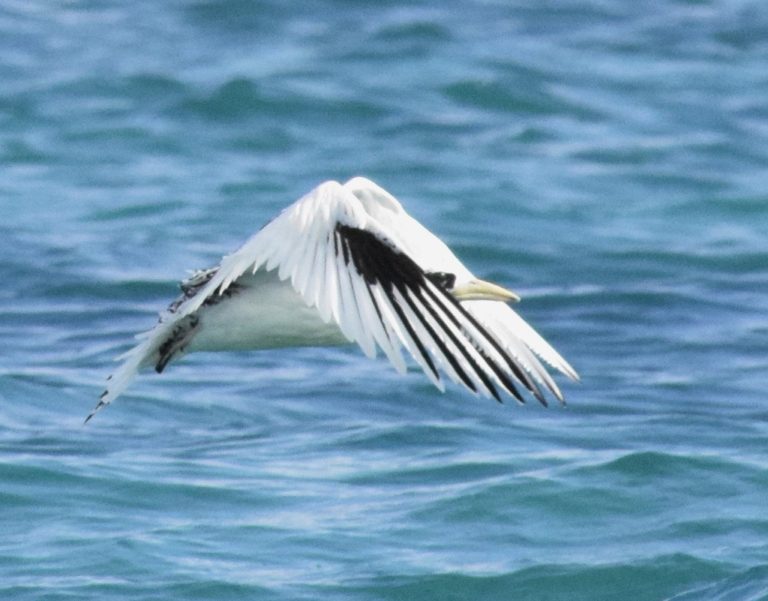
Red-billed Tropicbird, immature. (Isla de San Cristóbal, Galápagos, Ecuador; January 28, 2016.) © cedarleaf

Red-billed Tropicbird, immature. (Offshore from Santa Cruz Huatulco, Oaxaca, Mexico; March 31, 2017.) © Mark L. Hoffman
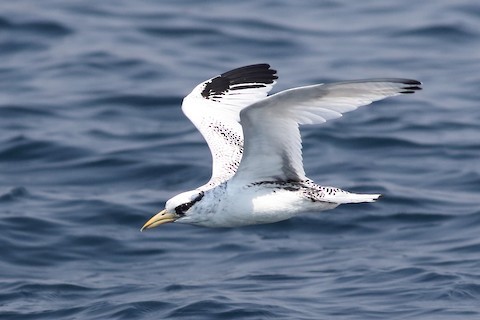
Red-billed Tropicbird, immature. (Offshore from Santa Cruz Huatulco, Oaxaca, Mexico; March 31, 2017.) © Mark L. Hoffman
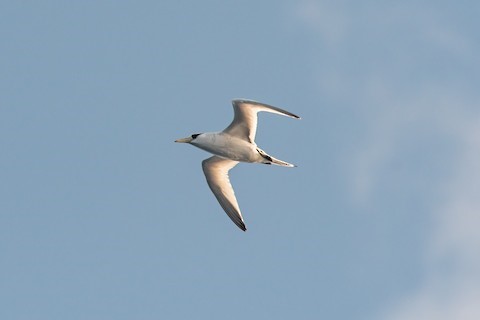
Red-billed Tropicbird, immature. (Offshore from Hatteras, North Carolina; May 26, 2018.) © Graham Gerdeman

Red-billed Tropicbird, immature. (Offshore from Hatteras, North Carolina; May 26, 2018.) © Bill Buckingham
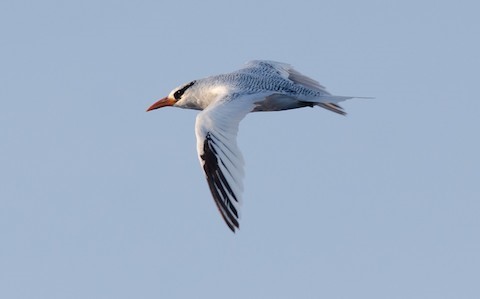
Red-billed Tropicbird, subadult. (Offshore from Pubnico, Nova Scotia; August 3, 2019.) © Alix d’Entremont
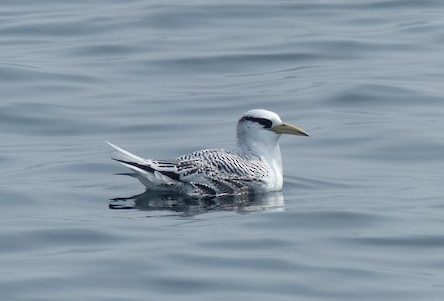
Red-billed Tropicbird, immature. (Offshore from Santa Cruz Huatulco, Oaxaca, Mexico; April 25, 2018.) © Chris Sharpe
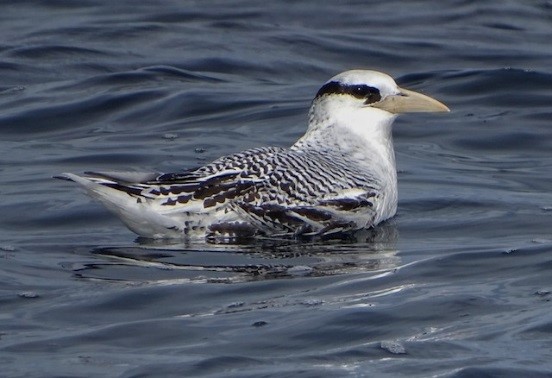
Red-billed Tropicbird, immature. (Offshore from Puntarenas, Costa Rica; January 7, 2017.) © Jorge Zuñiga Lopez

Red-billed Tropicbird, immature. (Offshore from Hatteras, North Carolina; June 1, 2015.) © Jay Gilliam

Red-billed Tropicbird, juvenile. (Little Tobago Island, Trinidad & Tobago; May 17, 2010.) © Nigel Lallsingh

Red-billed Tropicbird, immature. (Sinaloa, Mexico; June 4, 2017.) © Centro Integralmente Planeado Playa Espíritu. FONATUR, Sinaloa

Red-billed Tropicbird, immature. (Port Aransas, Texas; July 26, 2020.) © Noreen Baker
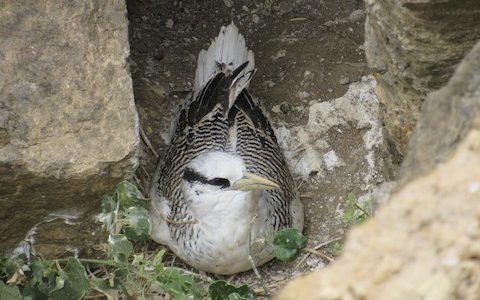
Red-billed Tropicbird, immature. (Isla de la Plata, Ecuador; September 9, 2017.) © Rafael Ferro
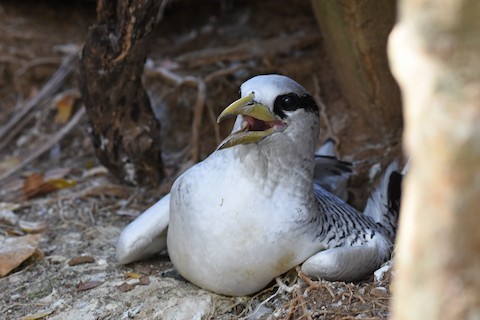
Red-billed Tropicbird, juvenile. (Little Tobago Island, Trinidad & Tobago; May 18, 2019.) © Janet Rathjen
Cf. Arabian Tropicbird. Red-billed and Arabian Tropicbirds are similar species that do not regularly come into contact with one another and would rarely be mistaken for one another on geographical grounds. However, some vagrants may cause confusion, as both have been photographed in Australia. The distinctions are also relevant to the question of taxonomic status.
Adult Red-billed and Arabian Tropicbirds differ in three distinctive features:
Tail: Arabian’s tail streamers rarely approach the length of the body, whereas Red-billed’s regularly grow much longer. Red-billed’s streamers are not always long, so short streamers do not rule out Red-billed, but long streamers confirm Red-billed.

Red-billed Tropicbird, showing longish tail streamers, bold, black eyestripe, thin, all-red bill, and fine barring on the back. (Little Tobago Island, Trinidad & Tobago; January 13, 2020.) © Steven Hunter

Arabian Tropicbird, showing typically short tail streamers, crescent teardrop marking, thick, black-edged bill, and relatively coarse barring on the back. (Perumal Par, Lakshadweep, India; January 13, 2015.) © Bijoy Kombarakkaran
Facial Markings: Adult Red-billed has a bold black eyestripe that extends from the eye to the hindcrown. Fully mature Arabian has no eyestripe, but instead has a crescent-shaped black “teardrop” marking. However, subadult and some apparently adult (but presumably young adult) Arabians retain an indistinct blackish eyetripe—somewhat resembling Red-billed’s eyestripe, but lacking its boldness and crisp contrast.
Bill: Arabian’s bill is proportionately shorter and thicker, and it has blackish edges whereas Red-billed’s is all-red.
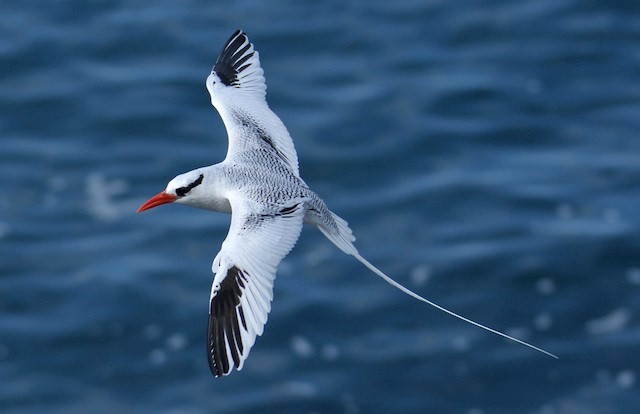
Red-billed Tropicbird, showing longish tail streamers, bold, black eyestripe, thin, all-red bill, and subtle carpal bars. (Isla Santa Fé, Galápagos, Ecuador; March 24, 2011.) © Jeremiah Trimble

Arabian Tropicbird, showing typically short tail streamers, crescent teardrop marking, thick, black-edged bill, coarse barring, and strong carpal bars. (Halulu Island Qatar; October 16, 2010.) © Gavin Farnell
There are additional, less distinctive differences in the upperparts: Arabian is more boldly barred overall and has bolder black bars on the wings—especially apparent in the inner portion, where it typically shows a pronounced carpal bar. These distinctions may help in some cases, but they are matters of degree where each species has a spectrum of variation, and the differences within species appear to exceed the differences within species.

Red-billed Tropicbird, subadult showing thin, unmarked, orangish-yellow bill. (Offshore from Hatteras, North Carolina; June 1, 2017.) © Skip Russell
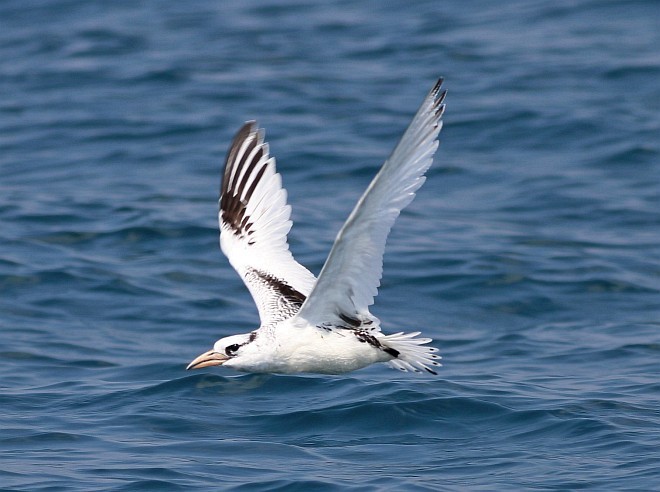
Arabian Tropicbird, immature showing thick, horn-colored, black-edged bill and strong carpal bar. (Offshore from Vasco da Gama, South Goa, India; November 5, 2017.) © Manjusha Savant
Immatures: Immature Red-billed and Arabian Tropicbirds are much more similar than the adults, and may be indistinguishable in many cases. The most reliable distinction appears to be bill color and pattern. Immature Arabian’s bill is horn-colored (sometimes pinkish) with distinct blackish edges, whereas Red-billed’s generally appears yellowish and has less distinct blackish edges. As they age their bills tend to brighten differently, with Arabian’s turning rosy-orange and Red-billed’s turning yellowish-orange.
They also show a weaker version of the adults’ plumage differences: immature Red-billed has a bolder black eyestripe, whereas immature Arabian has bolder black markings on the wings.
Cf. Catesby’s Tropicbird. Catesby’s and Red-billed Tropicbirds occur together across much of the Caribbean region and western North Atlantic. Viewed from below, they can be difficult to distinguish, even at close range in good light. Both have white tails and can have orange bills—though an adult with a bill that appears pale orange or yellow is likely Catesby’s, whereas a dark orange or red bill indicates Red-billed. They are best distinguished by dorsal pattern:
Adult Catesby’s has two thick black bars on each wing—one on its outer primaries (not including the coverts) and the other a diagonal carpal bar across its secondary coverts.

Catesby’s Tropicbird. (Spittal Pond Nature Reserve, Bermuda; August 7, 2019.) © Richard Caslon

Red-billed Tropicbird. (Gardner Bay, Española, Galápagos, Ecuador; November 4, 2016.) © Neil Wingert
Adult Red-billed typically has a single, longer black bar on the leading edge of the primaries, tapering inward on primary coverts, creating a sharp white “comma” at the wrist, and lacks the solid black carpal bar of Catesby’s. Some Red-billed have more heavily marked upperparts than average and may appear to have a carpal bar like Catesby’s, but on these individuals the rest of the back is also heavily marked, unlike Catesby’s.
Immatures of the two species can be very difficult to distinguish at sea, as both can have yellow bills, black primaries, and black barring across the back, rump, and wing coverts. The most reliable distinction is the head markings: Catesby’s has a short, smudgy eyeline, whereas Red-billed usually has a complete “headband,” as its eyelines extend back and join to form a collar on the nape.
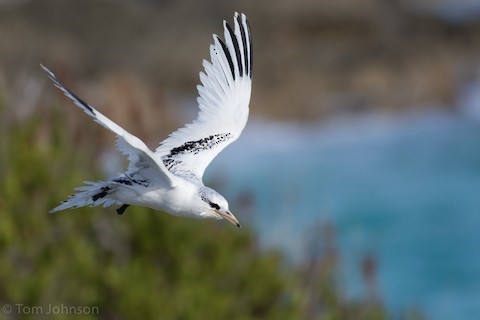
Catesby’s Tropicbird, juvenile. (Nonsuch Island, Bermuda; November 21, 2016.) © Tom Johnson

Red-billed Tropicbird, immature. (Offshore from Santa Cruz Huatulco, Oaxaca, Mexico; March 31, 2017.) © Mark L. Hoffman
Immature Catesby’s has whiter upperparts, particularly on the head and neck, and the black bar on its outer wing is limited to the primaries, covering the outer 25-30% of the wing and ending squarely—whereas on Red-billed the black bar extends onto the primary coverts, tapering toward the wrist, and spans almost 50% of the outstretched wing.
Notes
Polytypic species consisting of two recognized subspecies. Traditionally considered conspecific with Arabian Tropicbird (Phaethon indicus), but the differences between these forms are striking, and appear facially sufficient to regard them as separate species.
References
Alderfer, J., and J.L. Dunn. 2014. National Geographic Complete Birds of North America (Second Edition). National Geographic Society, Washington, D.C.
Ascanio, D., G.A. Rodriguez, and R. Restall. 2017. Birds of Venezuela. Christopher Helm, London.
BirdLife International. 2019. Phaethon aethereus. The IUCN Red List of Threatened Species 2019: e.T22696637A155736224. https://dx.doi.org/10.2305/IUCN.UK.2019-3.RLTS.T22696637A155736224.en. (Accessed August 20, 2020.)
eBird. 2020. eBird: An online database of bird distribution and abundance. Cornell Lab of Ornithology, Ithaca, N.Y. http://www.ebird.org. (Accessed August 20, 2020.)
ffrench, R. 2012. A Guide to the Birds of Trinidad & Tobago (Third Edition). Cornell University Press.
Garcia-del-Rey, E. 2011. Field Guide to the Birds of Macaronesia: Azores, Madeira, Canary Islands, Cape Verde. Lynx Editions, Barcelona.
Garcia-del-Rey, E. 2018. Birds of the Canary Islands. Christopher Helm, London.
Harrison, P. 1983. Seabirds: An Identification Guide. Houghton Mifflin, Boston.
Howell, S.N.G., and S. Webb. 1995. A Guide to the Birds of Mexico and Northern Central America. Oxford University Press.
Howell, S.N.G., and K. Zufelt. 2019. Oceanic Birds of the World. Princeton University Press.
Kirwan, G.M., A. Levesque, M. Oberle, and C.J. Sharpe. 2019. Birds of the West Indies. Lynx Edicions, Barcelona.
Lee, D.S., and W.A. Mackin. 2009. Red‐billed Tropicbird. West Indian Breeding Seabird Atlas, http://www.wicbirds.net/rbtr.html. (Posted February 25, 2009. Accessed August 20, 2020.)
Pyle, R.L., and P. Pyle. 2017. The Birds of the Hawaiian Islands: Occurrence, History, Distribution, and Status. Version 2 (January 1, 2017). http://hbs.bishopmuseum.org/birds/rlp-monograph/. B.P. Bishop Museum, Honolulu, Hawaii.
Raffaele, H. 1989. A Guide to the Birds of Puerto Rico and the Virgin Islands. Princeton University Press.
Raffaele, H., J. Wiley, O. Garrido, A. Keith, and J. Raffaele. 1998. A Guide to the Birds of the West Indies. Princeton University Press.
Ridgely, R.S., and P.J. Greenfield. 2001. The Birds of Ecuador, Volume II: Field Guide. Cornell University Press.
Ridgely, R.S., and J.A. Gwynne. 1989. A Guide to the Birds of Panama (Second Edition). Princeton University Press.
Sinclair, I., P. Hockey, W. Tarboton, and P. Ryan. 2011. Birds of Southern Africa (Fourth Edition). Random House Struik (Pty) Ltd. Cape Town, South Africa.
van Perlo, B. 2009. A Field Guide to the Birds of Brazil. Oxford University Press.
Wikiaves. 2020. Rabo-de-palha-de-bico-vermelho, https://www.wikiaves.com.br/wiki/rabo-de-palha-de-bico-vermelho. (Accessed August 20, 2020.)
Xeno-Canto. 2020. Red-billed Tropicbird – Phaethon aethereus. https://www.xeno-canto.org/species/Phaethon-aethereus. (Accessed August 20, 2020.)
